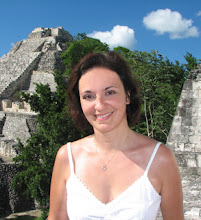.JPG)
This is not a guagua...this is a camionetta.
They sing about 'la guagua' in lots of salsa songs. It turns out to be not a baby (Chilean slang), but a bus. I thought it was the crummy kind of bus they pack people into and that spews pollution. But no. That, in Cuba, would be the el camionetta.
La 'guagua' is a coach, the kind of luxury affair tourists and fortunate Cubans use to cross the island. Equipped with on-board loos and video screens that work some of the time, the VIAZUL buses are reckoned to be the safest way to travel in Cuba. (Until recently the British foreign office advised against internal air travel in Cuba). Safe because they are sleek and well-maintained and the roads are good?
Nope. Mainly because they travel slowly on the pock-marked main Cuban freeway that even in Mexico would be a B-road, and where other cars are rare.
Our overnight guagua was making excellent time between Havana to Santiago de Cuba - on target for 14 hours. In fact, at 7am I was feeling rather sheepish at having dreaded the trip. I had to see the Oriente, to research my next book, but I was feeling a bit guilty, like it was too much to have asked of everyone else. But at 7am, we'd all enjoyed top-notch cat naps throughout the night and were looking forward to arriving within another five hours.
And then the bus stopped. In a little, teeny little town named Marti, between Ciego de Avila and Las Tunas, we passengers were emptied onto the pavement.
We were the only non-Cubans on the bus. There wasn't a peep of protest from any passenger, nor the tiniest hint of apology from the bus driver.
Hey, this is Cuba. It's understood that a long bus journey might take longer than anticipated. We all settled down on the roadside, to wait.
Nearby, from a window, a woman sold omelette and fresh cheese sandwiches, and cold cola drinks. I took my only small bills - 3 single CUCs. "How much for a sandwich?" I asked. "One peso," she said, raising a finger. "Not dollars," another customer told me, flashing a wallet full of Cuban moneda nacional. "Cuban pesos."
There are 24 Cuban pesos to the CUC. "Okay," I said. "How much do you want from me for the sandwiches? I only have dollars." The woman shrugged, blushed. "I dunno..."
"Make it up," I advised, thinking it a good lesson in capitalism. It was, after all, a seller's market. The woman gave me a small heap of egg and cheese rolls and then insisted, "Take some sodas too." She refused to take more than 2 CUCs.
A Cuban guy wearing an old-fashioned, gentlemanly beret offered to change some money for me (it's forbidden). So I bought 25 Cuban pesos and we had enough money to eat and drink for the next 8 hours. Four of those hours were spent just waiting in Marti. Watching boys practising baseball on the diamond opposite the bus stop, and talking quietly to the Cuban passengers from the bus.
.JPG)
-2.jpg)

No comments:
Post a Comment